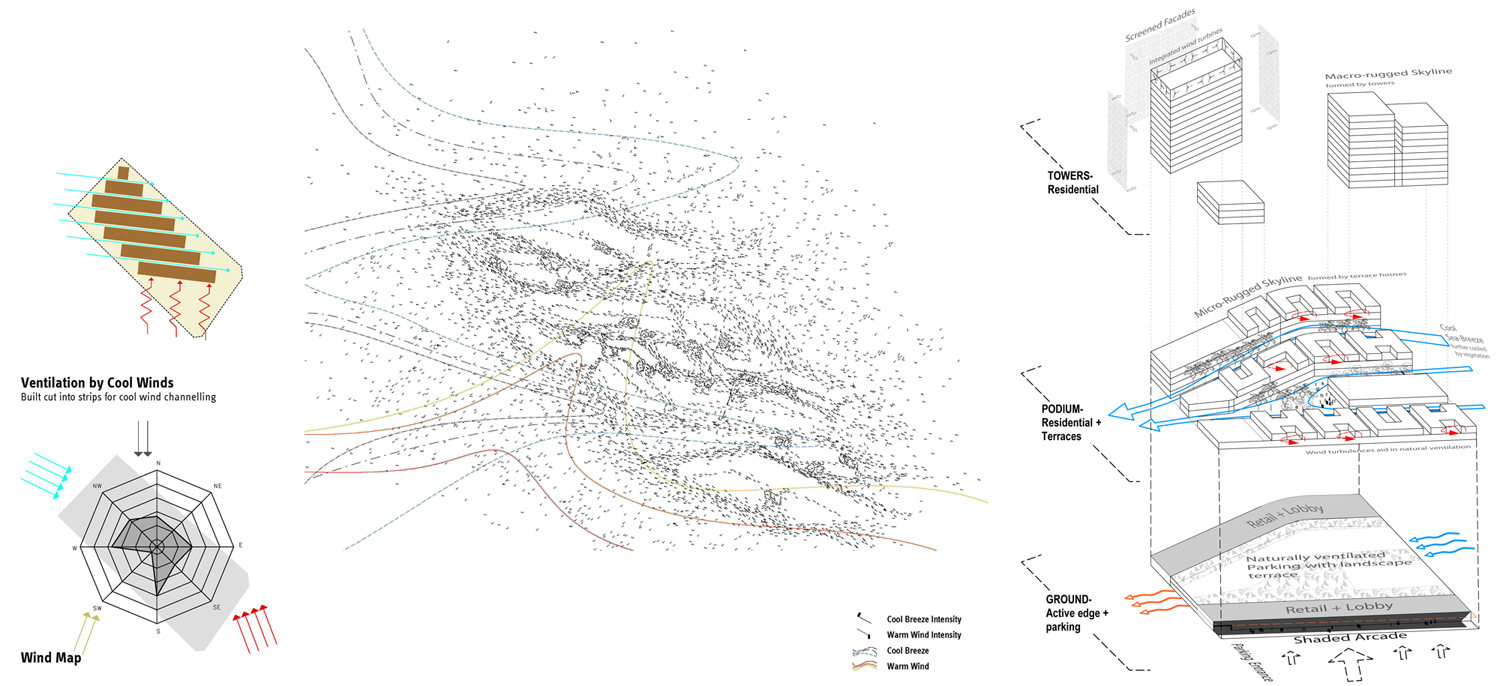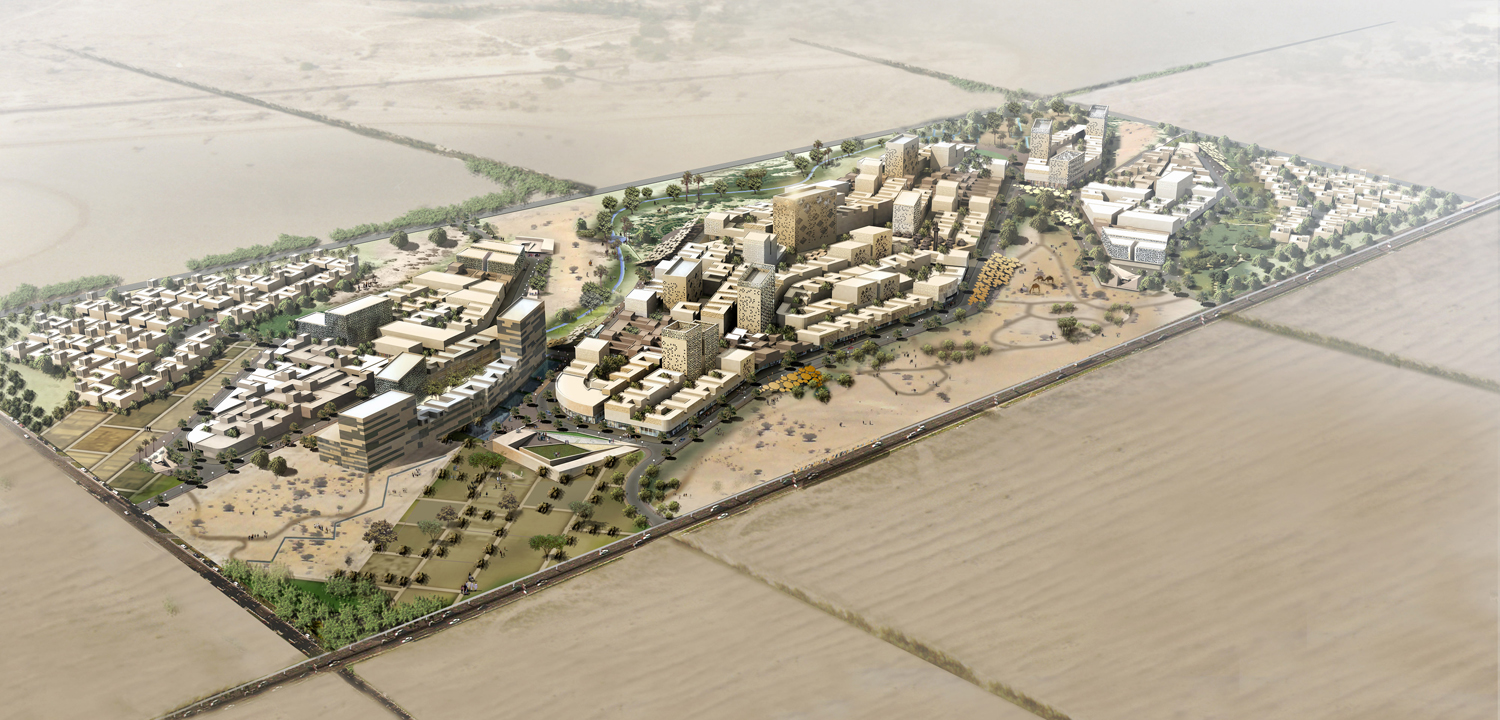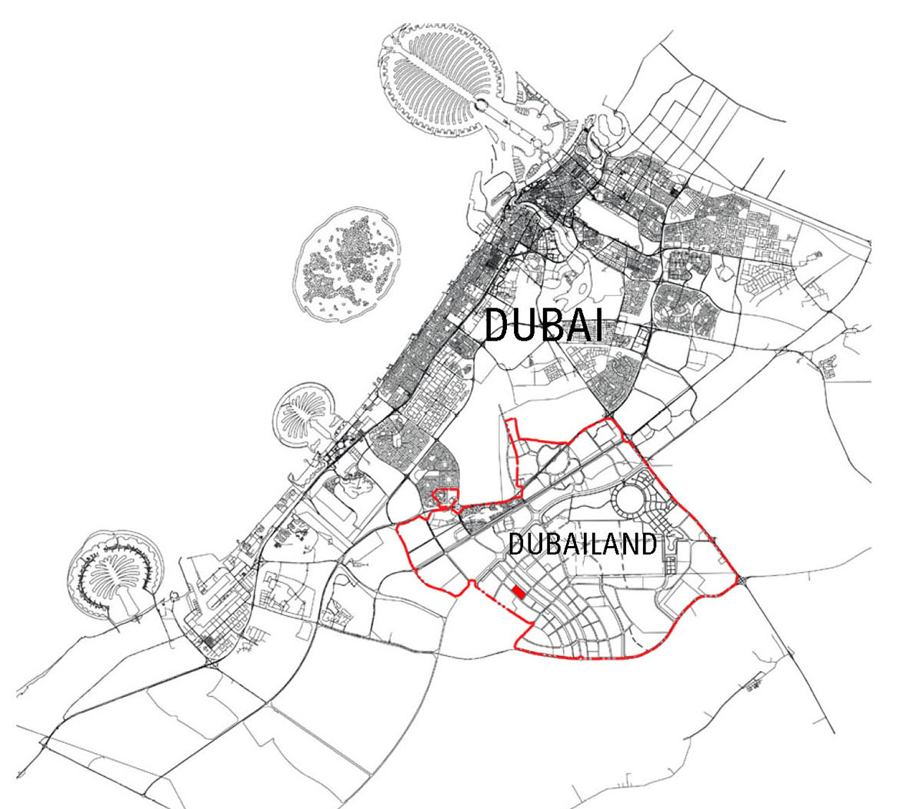Karim Elgendy
Throughout the last three decades, the city of Dubai has not been known for its emphasis on sustainability as guiding principles for its development. Not only did it adopt an unnatural rate of growth by middle eastern and global standards, it has also long disregarded the environmental and social consequences of its rapid urbanization. Dubai’s growth relied on -and was economically fueled by- a development model which imported inappropriate and inefficient building forms and planted them in its extreme climate. The result was a 1,500 square miles city (3,885 square kilometers) with isolated island buildings that are not only divorced from their environments, but which also require a great amount of fossil fuel energy to remain habitable.
The city of Dubai also has one of the highest carbon footprints per capita in the world, and even though this footprint is partially a result of energy intensive water desalination processes on which the city relies for its potable water, Dubai’s carbon footprint remains higher than that of other gulf cities including Saudi cities which also rely greatly on desalination.
In many ways, it is fair to argue that the Dubai’s model of development has been, in essence, the antithesis of sustainable development over the last three decades. In other words, Dubai has come to represent the climax of an obsolete development model in which humans attempted to subjugate their environment rather than coexist with it.
In contrast to this un-sustainable development pattern, Dubai’s neighboring city of Abu Dhabi has long adopted a measured and less extravagant development model. Over the same three decades, Abu Dhabi’s development model was generally characterized with a more sustainable pace of development. In the last few years, Abu Dhabi has been attempting to champion sustainable development in the Middle East by establishing a sustainability oriented framework for its development over the next 20 years, and by establishing the Masdar initiative which includes the world’s most progressive sustainable city project at its outskirts with ambitious zero-energy and zero-waste targets.
Dubai’s lack of a sustainable development framework similar to that of Abu Dhabi meant that any sustainability attempts it pursues are less integral to its development and are, by definition, limited to the single building scale. Dubai’s attempts to ‘green’ its development is also characterized with an emphasis on the buildings rather than the city with the establishment of a number of building-based initiatives such as the green building Regulations, the Emirates Green Building Council, and the adoption of LEED as a rating system.
In the years before the financial and real estate crisis hit dubai in 2009, Dubai-based commercial developers have actively marketed flashy designs that featured sustainable design strategies or ‘green features’. A closer examination of these ‘green’ designs shows that more often than not, these features were symbolic gestures that sought to greenwash the design of new large development. For example, a number of concept designs for tower projects have featured symbolic wind turbines and photovoltaic cells, which in spite of being visible statements of a ‘green’ intention, have limited impact on the energy use of the buildings they were integrated into. An extreme example of how sustainability was employed to justify extravagant design is a tower project that rotates slowly around its axis using renewable wind energy to power this rotation.
But not all green designs in Dubai can be dismissed as greenwash, other green designs appeared to be attempts to employs sustainability as a new trend as developers rushed for more iconic buildings in Dubai’s plethora of urban trends. Examples of these projects are tightly insulated glazed tower projects such as the Energy Tower (Burj Altaqa) and the Oasis Tower. Many of these concept designs are far from genuine attempts to design sustainable buildings as broadly defined today; buildings that have a reduced impact on the environments, and which, by virtue of their reduced energy use, do not contribute negatively to global warming.
But there are exceptions to these projects, represented in a small number of projects that appear to genuinely attempt to design sustainable buildings and developments in Dubai in spite of the lack of a sustainability framework. One these few exceptions is Xeritown.
Xeritown
Xeritown is a 59 Hectare mixed use development project (0.59 square Kilometer or 0.23 square mile) set to be built in Dubailand, a 107 Square mile (278 square Kilometers) inland development under construction in Dubai. When complete, Dubailand is expected have seven ‘themed worlds’ that would include theme parks, sports venues, eco-tourism, health facilities, science attractions, retail, hotels, and resorts. The large-scale development is expected to attract an additional 15 million tourists to Dubai (Images 1 and 2).
Xeritown appears to fall under Dubailand’s ‘eco-tourism’ category. Designed for Dubai properties, its development program called for providing a mix of residential buildings to accommodate 7000 inhabitants including apartments, townhouses, courtyard houses, and detached villas. The program also included retail spaces, a museum for desert life, and community facilities such as mosques, community halls, kindergartens, and sports and playground facilities.
But in spite of its extravagant commercial context, what is most interesting about Xeritown is its masterplan’s integrated approach to sustainable development. Unlike many ‘green projects’ in Dubai Xeritown’s masterplan concept places equal emphasis on energy conservation though passive design, as on the use of modern technologies. According to the architects, their focus was to “use the sun as passively as possible” and not to “build a big, alternative energy machine”.
The project’s main concept – and its name – are derived from the Xeriscaping, a modern landscaping technique. The concept of Xeriscaping was originally developed for landscaping in areas suffering from severe drought. It involves techniques to conserve water use and reduce plant maintenance. These techniques include using native plants that have adjusted to an area’s climate, as well as laying out plants in efficient ways to make the best use of water runoff. Xeriscaping, which has now been adopted in many dry regions of the world, is in architectural terms, landscape design’s equivalent of learning from traditional architecture and employing passive design strategies.
Xeritown’s Passive Urban Design
Crucial to the design of any sustainable development is designing a sound masterplan that responds to its local environment, and which establishes ground rules for a its low impact development. Fortunately, in designing Xeritown, the project team’s approach to the masterplan appeared to have placed environmental responsiveness as its main masterplanning criterion.
The design team, which was a collaboration between X-Architects, SMAQ, and Buro Happold, envisaged a a development that consists of a number of dense urban clusters located within a natural landscape. The built up area of the development masterplan was thus compressed to occupy only 50% of the site, which responded to the site’s solar geometry and helped achieve a compact and shaded urban fabric. Within this compact fabric, the masterplan’s urban structure is defined by alternating narrow pedestrian alleys and small squares, an urban form common in traditional Arabic cities.
The orientation of the urban fabric was optimized in order to maximize the desirable winds crossing the site. Cool northwesterly sea breezes are to be drawn between “islands” of development, whose form and orientation helps divert unwanted hot desert wind above the development (Image 3). Cool sea breezes are used to naturally ventilate outdoor spaces such as squares and terraces, as well as indoor spaces such as residences and underground parking in apartment buildings. Passive natural ventilation is also incorporated in villas, townhouses, and courtyard house with the integration of wind towers in their designs. The enhanced natural ventilation helps reduce the development’s energy needs by reducing the need for ventilation and air-conditioning.
Natural ventilation is also arguably enhanced by Xeritown’s rugged skyline, which, according to the design team, will help break up air flows. This interesting features and its estimated effect may surprise some as contrary to the common practice in hot dry climates of minimizing turbulence to improve air movement and retain wind speed .

Image 3. Massing studies showing how the masterplan responded to wind patterns and a study showing natural ventilation in apartment buildings. Copyrights: X-Architects and SMAQ
But the orientation of Xeritown was not only optimized for wind and natural ventilation. The city’s north west orientation would also help minimize solar heat gain on its buildings’ facades, which would, in turn, help reduce the cooling energy demand of the development’s interior spaces The masterplan also calls for screened facades which would help reduce indoor heat gain further (Image 4).
In outdoor spaces, the dense urban fabric of the city provides improved outdoor shading and creates opportunities for self shading. With some buildings reaching 12 stories (45 meters), most buildings are tall enough to block out the sun in adjacent areas for most of the day. Walkways leading along shops and homes also have significant overhangs.

Image 4. Massing studies showing how the masterplan responded to solar geometry. Copyrights: X-Architects and SMAQ
Outside of the reach of buildings and overhangs shading, the design team introduced additional shading elements. Metal stand-alone structures that take the form of flat circles will be placed to shade unshaded walkways. Interestingly, the project’s designers made a choice not to use more natural shading solutions such as palm trees or other plants (Image 5). In defense of their choice, The architects argue that not only would palm trees fail to provide sufficient shade, but that bringing in extra plants would also require extra water and energy to keep them alive since most vegetation in the United Arab Emirates is foreign and therefore energy intensive in this climate. They argue that this additional water and energy use would go against the resource conservation principles of Xeritown. This rationale and justification raises questions on how the energy and water requirements of palm trees and other plans would compare to the energy and water resources needed to manufacture the proposed alternative of metal structures.

Image 5. A 3D rendering highlighting shading elements such as overhands in retail areas, elevation screening, and the circular shading elements. Copyrights: X-Architects and SMAQ
In terms of landscape, the development’s landscape design strategy was also based on the compact masterplan design. The compact layout provides potentially humid areas in the squares and alleys that exist within the urban fabric. These outdoor spaces are conceived as a series of humid zones in an arid setting, where treated grey water is used to improve comfort conditions, and where humidity helps enhance the biodiversity of the their flora and fauna (Image 6).
Sustainable Infrastructure
In planning the city’s infrastructure, the designers sought to create pedestrian neighborhoods and to encourage pedestrian movements . But unlike Abu Dhabi’s radical car-free masterplan for Masdar City, the design of Xeritown represents a compromise solution with vehicular streets limited to two lanes. Theoretically, this arrangement could discourage driving, encourage public transportation and reduce private vehicular transportation to a minimum. The city’s extensive shaded and well ventilated pedestrian and cycling network, together with a proposed public transport network all work together to reduce the carbon emissions emitted by the city’s transportation systems. The city’s infrastructure also features waste-recycling facilities, now standard in most sustainable developments.
Integrated Systems
In addition to the city’s environmentally responsive design, its masterplan also features a number of design guidelines and infrastructure systems that would help reduce its energy demands. For example, the masterplan includes references to systems such as earth pipes as a strategy for cooling outdoor spaces through contact with the almost-constant earth temperature. The city’s street lamps would also use energy-efficient and dimmable LED lighting according to the masterplan.
Renewable energy sources also represent a significant part of the development infrastructure. Photovoltaic panels would be installed on top of the circular outdoor shading devices, generating energy that will be used to light spaces such as building lobbies and underground parking areas. Wind turbines will also be integrated into building roofs and the electricity generated – albeit fractional relative to energy demand – would be sold back to the electricity grid (Image 6).
Water
Given the location of the project, water conservation represented one of the main focus areas for the design team. In Xeritown’s masterplan, potable water would be limited to domestic uses. For non-domestic uses such as irrigation systems, recycled grey water or industrial waste water will be used. The low-maintenance landscape recommended would require less irrigation, and the residences would also be equipped with low water-use appliances.

Image 6. A sustainable systems diagram showing ventilation, shading, as well as integrated energy and water systems. Copyrights: X-Architects and SMAQ
Reflections
Judging by the context of its site within the Dubailand super-development, it might be easy to dismiss Xeritown as a ‘green’ section in a Dubailand’s tourist oriented ‘themed worlds’. But closely examining the strategies and features incorporated into the project demonstrates that the city’s designers have chosen substance over image. With the exception of the wind turbines, most of the strategies adopted are about performance rather than a ‘green’ image. The passive design features proposed also appear to resonate with traditional environmentally responsive designs rather than imported models of sustainability. Equally importantly is the scheme’s integration of appropriate technology and modern technology which is commendable as it signals a positive change in attitude towards local traditional architecture in Dubai and the lessons learned from it.
Given the number of projects that have been placed on hold in Dubailand over the last year, it is unclear as to whether Xeritown will proceed forward towards a built scheme. But if constructed, we hope that it would represent an important precedent and a positive step forward for sustainable development Dubai.
Karim Elgendy is an architect and sustainability consultant based in London. He can be contacted at: Karim [AT] Carboun [DOT] com
To discuss this article, please join Carboun’s vibrant discussion group on Linkedin. For news and updates on sustainability from around the region, join Carboun’s Facebook page or follow its Twitter feed.


